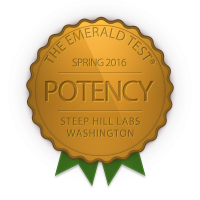The Emerald Test advisory panel recently convened to review the results from the Fall 2016 round of the semi-annual Inter-Laboratory Comparison and Proficiency Test (ILC/PT), ahead of the third annual Emerald Conference just a few weeks away. After reviewing and analyzing the results, the panel noticed a significant improvement across the board over their Spring 2016 round of proficiency testing.![]()
Emerald Scientific’s ILC/PT program is a tool laboratories use to check how accurate their testing capabilities are compared to other labs. A lab receiving The Emerald Test badge indicates their testing meets the criteria established by the panel to demonstrate competency. This means that they were within two standard deviations of the consensus mean for all analytes tested, according to Wes Burk, vice president of Emerald Scientific. He says the labs performed better than expected on both the microbial and pesticide tests.

 Each lab has access to raw, anonymized data including a consensus mean, z-scores and kernel density plots. This round measured how well 35 cannabis labs perform in testing for potency, pesticides, residual solvents and microbial contaminants such as E. coli, Salmonella, Coliform, yeast and mold.
Each lab has access to raw, anonymized data including a consensus mean, z-scores and kernel density plots. This round measured how well 35 cannabis labs perform in testing for potency, pesticides, residual solvents and microbial contaminants such as E. coli, Salmonella, Coliform, yeast and mold.
The advisory panel includes: Robert Martin, Ph.D., founder of CW Analytical, Cynthia Ludwig, director of technical services at AOCS, Rodger Voelker, Ph.D., lab director, OG Analytical, Tammie Mussitsch, QA manager at RJ Lee Group, Shawn Kassner, senior scientist at Neptune & Company, Inc., Jim Roe, scientific director at Steep Hill Labs, Chris Hudalla, Ph.D., founder and chief scientific officer at ProVerde Labs, Sytze Elzinga, The Werc Shop and Amanda Rigdon, Chief Technical Officer at Emerald Scientific.

According to Amanda Rigdon, chief technical officer at Emerald Scientific, the labs performed very well in potency, residual solvents and microbial testing PTs. This is the first year the proficiency testing includes pesticides. “All of the labs did a great job identifying every pesticide in our hemp-based PT, but some more work will most likely have to be done to bring quantitative results in line,” says Rigdon. “Since this was the first pesticide PT we had offered, we were pretty conservative when choosing analytes and their levels. For the most part, analytes and levels were taken from the Oregon pesticide list, which is widely recognized to be the most reasonable and applicable pesticide list out there to date.” They covered pesticides of high concern, like abamectin and Myclobutanil, but also included a wide range of other pesticides that labs are expected to encounter.

Shawn Kassner, senior scientist at Neptune & Company, Inc., believes microbial contamination proficiency testing should be a priority for improving public health and safety going forward. Although five participating labs did not receive badges for the microbial contamination PTs, panel members say the overall performance was really quite good. “Microbiology testing are essential analyses for all cannabis products and it’s just slower in regulatory implementation than potency testing,” says Kassner. “The risk of Salmonella and E. coli to an individual using a medical cannabis product could be very life threatening. Microbiology contamination is a huge concern for any public health agency, which is why we have seen that microbiology testing is usually the first analytical test required after potency.” Kassner notes that there were few outliers and with each Emerald PT program, he is seeing an improvement in overall laboratory performance.
For The Emerald Test’s next round, the panel hopes to make some improvements in the test’s robustness and consistency, like obtaining assigned values for all samples and comparing to a consensus mean. “We want to develop permanent badge criteria, streamline the appeals process and possibly implement a qualitative performance review in the pesticide PT,” says Burk. For the next round of pesticide PTs, they want to build a better list of pesticides to cover more states, allowing labs to pick a set based on their state’s regulations. Burk says they also want to collect data on whether or not matrix-matched curves were used for pesticides.
Rodger Voelker, Cynthia Ludwig and Shawn Kassner, all members of the advisory panel, will be speaking at the Emerald Conference, discussing some of their findings from this round of proficiency testing. The Emerald Conference will take place February 2nd and 3rd in San Diego, CA.







